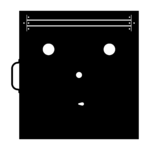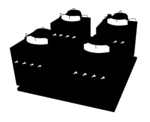Chapter Outline: Difference between revisions
No edit summary |
No edit summary |
||
| (237 intermediate revisions by 4 users not shown) | |||
| Line 1: | Line 1: | ||
< | <div class="title">The Fabulous Loop de Loop</div> | ||
< | <div class="subtitle"><em>A cybernetic discourse as read through seven feedback machines</em></div> | ||
<div class="byline">A project by Steve Rushton</div> | |||
<p class="chapter-outline-intro" style="margin: 1em 25%;padding: 1.3em;"> | |||
Samuel Butler’s ''Darwin Among the Machines'' (1863) anticipates a now familiar science fiction narrative.<br> | |||
<br> | <br> | ||
Butler supposed that in the near future machines would evolve to the point where humans would be enslaved by their superior machine-masters. In the text Butler recognised that the discourse of evolution and the discourse of the self-correcting steam engine (regulated by the governor) were inextricably bound.<br> | |||
<br> | <br> | ||
The principle which affords the self-correction of a species within an environment, and the self-correction of the governor within a “vapour engine” were the same, Butler realised.<br> | |||
<br> | |||
==THE | The Fabulous Loop de Loop examines how Butler's premise extends into the twentieth century.<br> | ||
<br> | |||
In the cybernetic era, the principle regulating both biological and machine organisation would be understood as negative entropy. The understanding that the entropic forces of the universe are frequently (locally) stalled or reversed called for a re-evaluation of a number of disciplines across the natural and social sciences.</p> | |||
__NOTOC__ | |||
==THE FABULOUS LOOP de LOOP – A BRIEF OVERVIEW== | |||
Cybernetics, in its contemporary sense, came into existence when the traditional notion of feedback loops, which has its origins in engineering (as performed by Ktesibios’ water clock or Watt’s steam engine) was bound to the modern concept of information (that the meaning and context of a message are not connected and that information can be measured in a binary unit). <ref> To trace the etymology, Kubernetes is the ancient Greek, and the source of the word steersman. The thgird centuary Neoplatonist Plotinus invoked the term in a negative sense. The steersman should not be so preoccupied with worldly events that they be distracted from higher thoughts from which these events originate. ''Erik Davis, TechGnosis, Myth, Magic & Mysticism in the Age of Information'', North Atlantic Books , 2015, p 89.</ref> | |||
The two disciplines were later brought together into the term Information Theory and were simultaneously theorised by Norbert Wiener and Claude Shannon. | |||
Cybernetics was practiced and theorised in a number of research cultures, to begin with principally for the U. S. military in the 1930s and 40s, and later in a wide variety of contexts. Post WWII, cybernetic ideas impacted society on all levels, politically, culturally, militarily, scientifically, even as its institutional presence dissipated at the end of the 1960s. | |||
The key principles outlined in Behavior, Purpose and Teleology by Arturo Rosenblueth, Norbert Wiener and Julian Bigelow (1942) and A Logical Calculus of the Ideas Immanent in Nervous Activity by Warren McCulloch and Walter Pitts (1943), along with the information theory of Claude Shannon (1947) provided a frame that allowed for the equivalence between mechanical and biological systems. | |||
The first cybernetic creatures (such as those built by William Grey Walter and William Ross Ashby), self-organised and adapted to their environment, providing models for the workings of the nervous system of animals and humans. If behaviour in both animal and machine is regulated by information flows through a circuit, both might also be understood as ordered through stochastic processes, organised by probability, performing computational acts. This was understood as an expression of negative entropy. | |||
The writers and artists I discuss in The Fabulous Loop de Loop sought to accommodate the implications of a “new” epistemology of circular causality to their own fields of research: Lacan to psychoanalysis; Burroughs to literature; the Radical Software group to art and (media) ecology. This epistemological shift did not come overnight, I also examine the development of this discourse from the nineteenth century with reading of the work of Samuel Butler and, as we approach the era of cybernetics, the work of William Bateson and Kenneth Craik. These figures prepare the ground for a group of thinkers who developed a discourse on cybernetics in the middle of the twentieth century. | |||
The polymath Gregory Bateson wrote in parallel with many of these thinkers. Bateson was a central figure in realizing the Macy Conferences on cybernetics (1946-1953). He was a key figure in reforms to psychiatric practice in the 1950s and was an intellectual force within the ecology and counterculture movements of the 1960s and 1970s. Throughout his career Bateson developed lines of communication between different discoursive spaces, which represented a holistic cybernetic epistemology. I will hold Key texts by Bateson, dating from the mid 1930s to the 1970s, as companion stars to the authors listed above. I aim to provide a very slim cross section which describes the institution of a broader cybernetic discourse. | |||
In the cybernetic | In The Fabulous Loop de Loop I am concerned with the way ideas can travel from one discursive space to another. For me, Bateson expresses the protean nature of cybernetic ideas more effectively than any other thinker. Bateson repeatedly draws our attention to an “outmoded epistemology” in which the nineteenth century energy model reaches the point of exhaustion. This, Bateson argues, must be replaced by an “ecology of mind” in which negative entropy is the central agent; in which individual choice provides “the difference that makes a difference”. Bateson's ability to synthesis different bodies of knowledge becomes apparent, as he transits from one epistemological sphere to another without significant violence to reason. | ||
STRUCTURE OF THE TEXT | |||
The Fabulous Loop de Loop comprises twenty one chapters. Each chapter examines attempts (from the 1870s to the 1970s) to narrate a new system of knowledge in which the discourse of energy is replaced by the discourse of information. | |||
The passage of the cybernetic model of negative entropy will be charted by seven feedback machines. These machines serve as agents in extending the discourse of cybernetics across a number of different scientific, social and cultural domains. | |||
# The Vapour Engine, regulated by the ''Governor''. This self-regulating machine becomes the exemplar of the broad principles of cybernetics and binds the discourse of evolution to the discourse of the machine. | |||
# William Gray Walter’s ''M. Specularix (the Cybernetic Tortoise)'' was built in the late 1940s. It performed as a model for the cybernetic conception of neural activity; | |||
# Claude Shannon & David Hagelbarger’s ''SEER (SEquence Extrapolating Robot)'' was developed at the Bell Labs in the early 1950s. The machine was able to play a human at the game of “ones and twos” and is regarded as one of the first “thinking machines”; | |||
# Alfred Korzybski’s ''Structural Differential (Anthropometre)'' (1924) was a “plastic diagram” which, in Korzybski’s theory of General Semantics, modelled the relation between an object-event and the human nervous system. The machine can be understood as a a technology of self-reflexivity. | |||
# The ''E-Meter (Electropsycometer)'' was used in Scientology auditing sessions. The E-Meter served as a psychological feedback mechanism, regulating the actions and re-actions of the user. For William Burroughs, a Scientologist and media activist, this machine has a strong performative potential which, along with a series of other media apparatus, had the power to reshape reality. | |||
# The ''Homeostat'' was developed by William Ross Ashby. It explored the degree of self-organization afforded within a complex system. The machine adapted to disturbances to its ultrastable state. | |||
# The ''Sony Videorover II AV-3400 (Portapak)''. Used within the counterculture of the 1960s the video system became an operational model on which visions of an ecologically sustainable society could be mapped onto a utopian media ecology. | |||
Central to my narration of cybernetics is a reassessment of how change and adaptation concurrently occur across a wide variety of disciplines such as physics, biology, evolution and ecology. This re-evaluation reaches deep into the social sciences and the humanities, making claims on the discourses of anthropology, psychology, psychoanalysis, aesthetics and sociology. | |||
I use the term “a” cybernetic discourse in the byline to this text because I want to make clear that The Fabulous Loop de Loop describes the site of an epistemological struggle. The term “cybernetics” is far from stable. In The Fabulous Loop de Loop we will see how different thinkers draw on different elements of the past to establish new foundations and project into different imagined futures. | |||
<br> | |||
== | ==CHAPTERS== | ||
[[File:GV_silhouette.png| | [[File:GV_silhouette.png|150px|thumb|link=THE GOVERNOR]] | ||
===[[THE GOVERNOR|THE GOVERNOR]]=== | ===[[THE GOVERNOR|THE GOVERNOR]]=== | ||
<div class="chapter-icon">[[File:GOV_01.png|250px|link=]]</div | <div class="chapter-icon">[[File:GOV_01.png|250px|link=The Vapour Engine]]</div> | ||
====[[The Vapour Engine]]==== | |||
====[[ | Samuel Butler understood that when the “vapour engine” regulated by a governor, arrived there was suddenly a new way to understand evolution. This brought the discourse of the machine and the discourse of the organism together. Gregory Bateson (a keen reader of Butler) understood this to be the instrument that would bring the natural and social sciences into the same epistemological space. | ||
Butler further recognised that the machine-organism debate demanded scrutiny of two issues: | Butler further recognised that the machine-organism debate demanded scrutiny of two issues: | ||
(a) the relation between organism and machine centred on the issue of design and purpose. Butler held that conscious purpose itself evolved from a series on non-conscious actions that came into consciousness. The key concern of Butler, which is evident across the texts we will discuss in this chapter, is the evolution of consciousness. In opposition to the idealism of the time, Butler argued, mind and matter are indivisible | <p class="indent"> | ||
(a) the relation between organism and machine centred on the issue of design and purpose. Butler held that conscious purpose itself evolved from a series on non-conscious actions that came into consciousness. The key concern of Butler, which is evident across the texts we will discuss in this chapter, is the evolution of consciousness. In opposition to the idealism of the time, Butler argued, mind and matter are indivisible<br> | |||
(b) the transmission of information down generations affords adaptation and consolidates order. | (b) the transmission of information down generations affords adaptation and consolidates order. | ||
</p> | |||
<div class="chapter-icon">[[File:GOV_02.png| | <div class="chapter-icon">[[File:GOV_02.png|250px|link=Vibrations]]</div> | ||
====[[ | ====[[Vibrations]]==== | ||
Samuel Butler’s proto-cybernetic speculation provided a model for “the father of modern genetics” William Bateson. William Bateson sought to navigate energetic problematics by allowing that genetic information is cycled through an organism ¬– consolidating order within a larger system. In Problems of Genetics | Samuel Butler’s proto-cybernetic speculation provided a model for “the father of modern genetics” William Bateson. William Bateson sought to navigate energetic problematics by allowing that genetic information is cycled through an organism ¬– consolidating order within a larger system. In ''Problems of Genetics'' (1913) William Bateson attempts to account for variation without an adequately theorised notion of negative entropy. William’s son, the polymath Gregory Bateson, extended the ideas of the elder Bateson (and re-purposed the writings of Samuel Butler) to develop an ecology of mind which was wholly cybernetic. The chapter will also compare William Bateson's conception of evolution to that of his contemporary, Henri Bergson, whose ''Creative Evolution'' (1911) also struggled with the nineteenth-century energy crisis. | ||
<div class="chapter-icon">[[File:GOV_03.png|250px|link=A (Proto) Cybernetic Explanation]]</div> | |||
<div class="chapter-icon">[[File:GOV_03.png|250px|link=]]</div | ====[[A (Proto) Cybernetic Explanation]]==== | ||
====[[ | |||
The war-time technologies of scanning devices and predictive servomechanisms, when added to the repertoire of neurophysiological experimentation, afforded the production of new models of the machine-organism. | The war-time technologies of scanning devices and predictive servomechanisms, when added to the repertoire of neurophysiological experimentation, afforded the production of new models of the machine-organism. | ||
These included the “thinking machines” discussed throughout | These included the “thinking machines” discussed throughout ''The Fabulous Loop de Loop'': William Ross Ashby’s Homeostat, William Grey Walter’s Tortoise, Norbert Wiener’s Moth-Bedbug and Claude Shannon & David Hagelbarger’s SEquence Extrapolating Robot (SEER). | ||
Central to this conception of organic order was a new definition of purpose, in which information cycles within a system to consolidate order and afford greater adaptation (negative entropy, or negentropy). | |||
Neurophysiology – as practiced by a number of cyberneticians including Grey Walter, Edward Craik, Ross Ashby, Warren McCulloch – is central to the discourse of cybernetics. The argument that mind is constituted through a series of iterative, non-conscious actions was far advanced within the research cultures of experimental psychology long before it established an alliance with the burgeoning discipline of control and communications. A well-established “experimental epistemology” (to use Warren McCulloch’s term) had been practiced in the fields of neurological and brain research from the turn of the century. The meeting of the discourse of neurophysiology and that of war-time research involving servo-mechanisms produced a new formal theory of feedback and control technologies – cybernetics. | |||
Edward Craik was a British experimental psychologist who died in 1945 at the age of 32 (just on the cusp of “the cybernetic moment”). Craik, in ''The Nature of Explanation'' (1943), argues for an anti-cartesian, non-vitalistic “hylozoism” – which is to say that mind is a function of matter rather than an essence opposing matter. For Craik, consciousness is delimited by the material constraints of the nervous system. Central to Craik’s thought is the idea of the mind modelling reality, which works “in the same way as the process it parallels”; thought, in the action of modelling reality, does not copy reality because “our internal model of reality can predict events which have not occurred” This predictive ability is “down hill” all the way. It is negentropic, because it saves energy which can be used to consolidate order within the system as the information cycles within an iterative circuit. | Edward Craik was a British experimental psychologist who died in 1945 at the age of 32 (just on the cusp of “the cybernetic moment”). Craik, in ''The Nature of Explanation'' (1943), argues for an anti-cartesian, non-vitalistic “hylozoism” – which is to say that mind is a function of matter rather than an essence opposing matter. For Craik, consciousness is delimited by the material constraints of the nervous system. Central to Craik’s thought is the idea of the mind modelling reality, which works “in the same way as the process it parallels”; thought, in the action of modelling reality, does not copy reality because “our internal model of reality can predict events which have not occurred” This predictive ability is “down hill” all the way. It is negentropic, because it saves energy which can be used to consolidate order within the system as the information cycles within an iterative circuit. | ||
<div class="chapter-icon">[[File:GOV_04.png|250px|link=]]</div> | <div class="chapter-icon">[[File:GOV_04.png|250px|link=From Schizmogenesis to Feedback]]</div> | ||
====[[From Schismogenesis to Feedback]]==== | |||
<div class="chapter-icon">[[File:GOV_05.png| | Gregory Bateson was able to reformulate his earlier theory of schismogenesis (1935) after his introduction to cybernetics in the 1940s. The theory of schismogenesis arose from Bateson's anthropological study of the Iatmul people in New Guinea. It attempted to diagnose the conflicts and divisions that occur in social groups, and tried to account for how social groups retain order over the long term. Following Bateson's introduction to cybernetics he was able to re-frame schismogenesis in terms of positive and negative feedback. From this point Bateson is able to frame past thought in terms informed by cybernetics. This included a reassessment of Samuel Butler, Korzybski’s general semantics and his father’s insights into genetics. At this point in Bateson’s career negative entropy becomes the organising principle which regulates a number of social, ecological and cultural systems, a post-cybernetic epistemology. | ||
====[[ | <div class="chapter-icon">[[File:GOV_05.png|250px|link=Cybernetics - Dynamic Psychology]]</div> | ||
In the early 1950s Gregory Bateson considered the implications of the epistemological shift occasioned by cybernetics to the field of psychiatry and psychoanalysis. His book Communication: The Social Matrix of | |||
I will bring into the argument two texts by cyberneticians who contributed to the discourse of | ====[[Cybernetics - Dynamic Psychology|Cybernetics - Dynamic Psychology]]==== | ||
In the early 1950s Gregory Bateson considered the implications of the epistemological shift occasioned by cybernetics to the field of psychiatry and psychoanalysis. His book ''Communication: The Social Matrix of Psychiatry'' (1951) (co-authored with psychiatrist Jurgen Ruesch) gives an account of this. In the tradition of Butler and Craik, Bateson presented a conception of the human subject in which mind is co-extensive with system. Bateson presents an anti-Cartesian, hylozoist, view in which mind and matter are indivisible. This conception of psychiatry and psychoanalysis allowed Bateson to mount a critique of Freudian psychoanalysis on the basis of Freud’s outdated understanding of the distribution of energy within the psychic field, which for Freud followed a thermodynamic pattern (psychodynamics). | |||
I will bring into the argument two texts by cyberneticians who contributed to the discourse of psychodynamics in relation to emerging concepts of information. Warren S. McCulloch’s “The Past of a Delusion” (1951) represents the assassination of Freud’s energetics, from the perspective of a pioneer in both neurophysiology and the emerging cybernetic epistemology. The second paper is a more nuanced assessment of Freudian dynamics; Lawrence S. Kubie’s “The Fallacious Use of Quantitative Concepts in Dynamic Psychology” (1947) cautions against understanding Freudian psychodynamics as anything more than a loose metaphor – and as an increasingly less helpful metaphor as the age of cybernetics progressed. | |||
[[File:CT_silhouette.png|150px|thumb|link=M. SPECULARIX (The Cybernetic Tortoise)]] | |||
===[[M._SPECULARIX_(The_Cybernetic_Tortoise)|M. SPECULARIX (The Cybernetic Tortoise)]]=== | ===[[M._SPECULARIX_(The_Cybernetic_Tortoise)|M. SPECULARIX (The Cybernetic Tortoise)]]=== | ||
<div class="chapter-icon">[[File:CT_01.png|250px|link=The Body in Pieces]]</div> | |||
====[[The Body in Pieces]]==== | |||
Following the advice of Edward Craik, Gray Walter builds a servo-machine (the cybernetic tortoise) which combines the scansion of a WWII anti-fire system and the principles of experimental neurophysiology. The way in which the cybernetic tortoise orientates its environment is recursive, an action is dependent on cycling information which influences subsequent action. The machine does this by scanning, which orders the organism’s relation to space and time. Such behaviour is an expression of negative entropy “What the nervous system receives from the sense organs is information about difference – about ratios between stimuli” wrote Walter.<ref> Grey Walter</ref> | |||
<div class="chapter-icon">[[File:CT_02.png|250px|link=The Tortoise and Homeostasis]]</div> | |||
====[[The Tortoise and Homeostasis]]==== | |||
A little after the publication of Gregory Bateson & Jurgen Ruesch’s ''Communication: The Social Matrix of Society'' – as the cybernetic critique of Freudian dynamic psychology was developed – Jacques Lacan conducted his own re-evaluation of Freudian dynamic psychology. In line with those in the mainstream of cybernetics (and resonating with Samuel Butler’s own discourse analysis) Lacan identifies a shift from the discourse of knowledge to the discourse of the machine. This re-evaluation has its origins in a renewed understanding of homeostasis in relation to new theories of information and control. Indeed, ''Seminar II'' can be read as the scrutiny of an emerging discourse network, as a dominant set of technical standards are transformed. Lacan outlines the dialectic as follows: | |||
<p class="indent"> | |||
(a) the discourse of knowledge (characterised by the era of Hegel) is superseded by the discourse of the machine at the point where the discourse of entropy comes into being – this is embodied in the technical apparatus of the steam engine.<br> | |||
(b) the discourse of negative entropy, in the era of cybernetics, in turn challenges a number of models based on heat transference and displacement (such as Freud’s dynamic psychology) – this is embodied in the technical apparatus of the servomechanism (such as Grey Walter's Tortoise).<br> | |||
(c) the discourse of the machine takes its place at the centre of human subjectivity. Man is spoken by language, which moves in a circuit of communication exterior to the subject – this is the language of the machine. For Lacan (as with Bateson) a new understanding of entropy allows for a new conception of self in relation to system. The differences and similarities of approach are discussed in the following two chapters. | |||
</p> | |||
[[File:Mind-reading_machine_silhouette.png|150px|thumb|link=SEER (SEquence Extrapolating Robot)]] | |||
===[[SEER (SEquence Extrapolating Robot)]]=== | |||
<br> | <br> | ||
<div class="chapter-icon">[[File: | <div class="chapter-icon">[[File:SEER_01.png|250px|link=Play Like an Idiot]]</div> | ||
====[[Play Like an Idiot]]==== | |||
====[[ | The SEER (SEquence Extrapolating Robot) was developed by Claude Shannon & David Hagelbarger at the Bell Labs in the early 1950s. Its aim was to outplay a human in the game of matching pennies (aka, ones and twos / odds and evens). Lacan’s understanding of finite state automata (such as SEER) allowed him to theorize that simple information machines were structured similarly to simple languages with limited functions (recording their activities with a series of pluses and minuses); that the syntax of a finite-state automata was descriptive of the symbolic order. | ||
Here I revisit the ideas of McCulloch and Pitts, whose concept of neural feedback systems links the biological function of thinking with the function of mechanical computation. | |||
<div class="chapter-icon">[[File:SEER_04.png|250px|link=Odd or Even?]]</div> | |||
====[[Odd or Even?]]==== | |||
Lacan, in his analysis of Edgar Allan Poe’s The Tale of the Purloined Letter, and in his lecture on Cybernetics and the Unconscious, discussed Von Neumann & Morgenstern's ''Game Theory and Economic Behaviour''; the game of odds & evens (which is discussed in both Poe’s story and in Von Neumann & Morgenstern's book). Lacan also described the relation of both of these things to a “second guessing” finite state automata (similar to Shannon & Hagelbarger’s SEER) in order to outline the tendency of symbolic apparatus to produce patterns which are independent of human thought and which are nevertheless able to enter the symbolic order. | |||
<div class="chapter-icon">[[File:SEER_02.png|250px|link=Poe's Purloined Letter]]</div> | |||
====[[Poe's Purloined Letter]]==== | |||
In ''Seminar II'', Lacan analyses Edgar Allan Poe’s The Purloined Letter, in which the game of ones and twos features: “The human subject doesn't foment this game” Lacan states, “he takes his place in it, and plays the role of the little pluses and minuses in it. He is himself an element in this chain which, as soon as it is unwound, organises itself in accordance with laws. Hence the subject is always on several levels, caught up in crisscrossing networks.”<ref> Lacan Seminar II</ref> | |||
<div class="chapter-icon">[[File:SEER_03.png|250px|link=Lacan Builds a Circuit]]</div> | |||
====[[Lacan Builds a Circuit|Lacan Builds a Circuit]]==== | |||
Three elements of Lacan’s cybernetic discourse emerge in this chapter: | |||
<p class="indent"> | |||
(a) that the introduction of the symbolic into the domain of the real produces a circuit between signs, things, and subjects<br> | |||
(b) Lacan stresses the centrality of probability; the precedents for this, the “conjectural sciences” of the 1600s which studied ratios of difference and<br> | |||
(c) simple choice establishes a difference which establishes and consolidates order. | |||
</p> | |||
I conclude this chapter with a comparison between Lacan and Bateson's approach to psychoanalysis. Lacan sought to rehabilitate Freud in the cybernetic era whilst Bateson dismissed Freudianism and other “introspective”, “epistemologically outmoded” methods of psychoanalysis. But, in their approach to psychoanalysis and psychiatry via cybernetics, Bateson and Lacan have a lot in common. Both attempt to bring the psychic apparatus in line with the technical standards of the day; both recognise Freud’s model of the human psyche as conditioned by a nineteenth-century emphasis on entropy (the postponement and inhibition of discharge); both recognise that language is exterior to and constitutive of the subject; both recognise regulation of a system relies on the cycling of information through the circuit; that the subject is constituted within the threshold of restraints; both see organism and servomechanism as having a homological relation to each other – they have the same structure, they organise in the same way. Their respective ideas of the “subject” are also remarkably similar. | |||
[[File:SD silhouette.png|150px|thumb|link=THE STRUCTURAL DIFFERENTIAL (The Anthropometre)]] | |||
( | ===[[THE STRUCTURAL DIFFERENTIAL (The Anthropometre)]]=== | ||
( | <div class="chapter-icon">[[File:SD_A01.png|250px|link=Why “The Map is NOT the Territory”]]</div> | ||
====[[Why “The Map is NOT the Territory”]]==== | |||
Polish mathematician Count Alfred Korzybski’s Structural Differential (Anthropometre) (1924) is a “plastic diagram” and thought experiment which, in Korzybski’s theory of General Semantics, modelled the relation between an object-event and the human nervous system. The core ideas developed by Korzybski were used by Gregory Bateson and William S. Burroughs to articulate their own theories of communication. As readers of Korzybski, Burroughs and Bateson grappled with the implications of Korzybski’s time binding theory and the implications of confusing different levels of abstraction. While Burroughs sought to scramble and willfully hack the mechanisms of time binding, Bateson adopted aspects of the theory to conduct his own assault on the “errors of occidental epistemology”. | |||
Bateson adapted Korzybski’s term “the map is not the territory” to illustrate his own theory of communication and ecology. Both Korzybski and Bateson held that the distortions arising from category confusion were at the root of a general epistemological crisis. | |||
<div class="chapter-icon">[[File:CT_03.png|250px|link=Bateson’s Negentropic Discourse Matrix]]</div> | |||
====[[Bateson’s Negentropic Discourse Matrix]]==== | |||
( | I return to Bateson’s ''Communication: and the Social Matrix of Psychiatry'' (1951) and consider Bateson’s “epistemological graph” which charts the shift following the advent of cybernetics toward | ||
<p class="indent"> | |||
(a) “greater gestalten”,<br> | |||
(b) a move to understanding problems in human understanding as predicated on recently coined communication and information theories<br> | |||
(c) a more complex understanding of order and system which replaces the Newtonian epistemology of cause and effect. Although Bateson advocates new approaches he is again reliant on established practices which anticipated the implications of negative entropy. | |||
</p> | |||
===[[THE ELECTROPSYCOMETER (The E-Meter)]]=== | |||
<div class="chapter-icon">[[File: | [[File:EM silhouette.png|150px|thumb|link=THE ELECTROPSYCOMETER (The E-Meter)]] | ||
<div class="chapter-icon">[[File:EM_01.png|250px|link=Time-Binding and Time-Scrambling]]</div> | |||
====[[ | ====[[Time-Binding and Time-Scrambling]]==== | ||
The | The E-Meter (Electropsycometer) is used in scientology auditing sessions. The E-Meter is ostensibly a polygraph which registers a subject’s reaction to a series of questions; the galvanic charge produced by each response is picked up by two metal cans held by the subject. The occult narrative of scientology sits in isomorphic relation to Burroughs’ text Electronic Revolution. In this chapter I establish a relation between the E-meter, the Structural Differential and the tape recorder. When it was first developed The Structural Differential was used in a Pavlovian technique of stimulus-response to help people diagnosed as schizophrenic understand different levels of abstraction. In Electronic Revolution Burroughs advocates the use of the tape recorder as a form of radical software which confuses levels of abstraction, as a means of unbinding the subject from time. As a piece of tactical media Electronic Revolution flings Dianetics and General Semantics into an unexpected alliance. | ||
Burroughs is in agreement with Lacan and Bateson, it is at the level of syntax that the bedrock of consciousness is formed. For Burroughs the control system of language can be subverted by media tactics which scramble the code of language that anchors humans to permanent identity. | |||
[[File:HMST_silhouette.png|150px|thumb|link=THE HOMEOSTAT]] | |||
===[[THE_HOMEOSTAT|THE HOMEOSTAT]]=== | |||
(a) | <div class="chapter-icon">[[File:HS_01.png|250px|link=Steps Towards a (Media) Ecology]]</div> | ||
====[[Steps Towards a (Media) Ecology]]==== | |||
I consider various ecological models and consider how Gregory Bateson’s cybernetic ecology is best suited to translation into the philosophy of emergent media ecologies. | |||
( | [[File:PP_silhouette.png|150px|thumb|link=THE PORTAPAK: SONY VIDEOROVER DV-2400 (1967)]] | ||
( | ===[[THE PORTAPAK: SONY VIDEOROVER DV-2400 (1967)]]=== | ||
<div class="chapter-icon">[[File:PP_01.png|250px|link=The Fabulous Loop de Loop]]</div> | |||
====[[The Fabulous Loop de Loop]]==== | |||
Video artist Roy Skodnick: “Anyone who happened to get hold of a portable video system at the time immediately overloaded on circuits, playback, feedback, and fabulous loop de loop” | |||
The Fabulous Loop-de-Loop is a phrase attributed to the video artist Frank Gillette. The term is used to describe the environment produced by the combination of people and a portable video unit. In the late 1960s, such systems encouraged participants to understand that they are part of a larger cybernetic system (an ecology). | |||
Use of portable video equipment coincided with the emergence of an aesthetic movement which incorporated a number of technologies (lights, video, film, drugs) to produce an immersive environment. At the same time, and within the same culture, the portable video unit was also used as a tool for therapy and self-enhancement. | |||
The term ‘media ecology’ was developed in the pages of Radical Software in the early 1970s. Gregory Bateson's ideas were seminal to the development of the discourse of video art and video activism in the late 1960s and early 1970s. When artistic practice and discourse adopted ideas of self-reflexivity and radical mediality the influence of Bateson was apparent. The magazine Radical Software provided a forum for discussion, the dissemination of information, and the formulation of media theory, as well as a platform for established writers and theorists. At the same time these groups adopted technologies which proposed new systems of social organisation and new approaches to self understanding through video therapy. | |||
As a therapeutic tool the Portapak can be understood as an extension of earlier therapeutic technologies, such as Korzybski’ s Structural Differentia.<ref>and the Galvometer (which was used in the psychoanalysis of Jung).</ref> Like the Portapak, the Structural Differential afforded a high degree of reflexivity and required the user to consider their place within a larger system. The Structural Differential had the specific function of helping the user realise that human communication involves the management of different levels of abstraction (a method derived from Russell-Whitehead’s theory of logical types). The theory of types also provided the basis for Gregory Bateson and the Palo Alto research group who developed double-bind theory from 1954. | |||
[[File: | <div class="chapter-icon">[[File:PP_02.png|250px|link=Double Bind to Video Therapy]]</div> | ||
====[[Double Bind to Video Therapy|Double Bind to Video Therapy]]==== | |||
====[[ | |||
Three significant issues arose from the work of Bateson’s Palo Alto research group which have a bearing on the development of the video culture of the late 1960s and early 1970s. | |||
<p class="indent"> | |||
(a) The development of family therapy (which seeks to identify cyclical patterns of family interaction through group work)<br> | |||
(b) The development of double-bind theory (which has its origins in the conflict of levels of abstraction)<br> | |||
(c) The use of film and video in the execution and analysis of family therapy sessions – which allows for the generalisation of video therapy (it can be used by anyone as a therapeutic tool).<br> | |||
</p> | |||
Video therapy followed a tradition of self-reflexive therapy and breaks the duality between self and environment. Such cybernetic bio-feedback devices, as used by tactical media pioneers TVTV, Ant Farm, and Radical Software, propose new social-technical-media ecologies. Feedback technologies including the Porta Pak and closed-circuit TV – which promised new forms of social organisation as well as new forms of therapy – can be seen in direct relation to the post-Freudian, cybernetic theories of Bateson and Lacan, and the reflexive therapies of Korzybski and Stack-Sullivan. | |||
[[File: | <div class="chapter-icon">[[File:PP_03.png|250px|link=Double Bind's Double life]]</div> | ||
====[[Double Bind's Double life]]==== | |||
====[[ | |||
This chapter will consider how the ideas of Gregory Bateson interweave different strands through the culture of the late 1960s | |||
<p class="indent"> | |||
(a) In the field of therapy – an emphasis on group therapy and the double bind<br> | |||
(b) In the field of aesthetics – an emphasis on self-reflexivity, process and context specific forms of art<br> | |||
(c) Within the counterculture – proposing a cybernetic epistemology and [media] ecology.<br> | |||
</p> | |||
A brief analysis of R.D. Laing's application of the double bind and Frank Gillette's consideration of different levels of abstraction closes the fabulous loop de loop. | |||
To conclude… such practices promised something beyond the divided or decentred self of post-Freudian post-cybernetic psychoanalysis and psychiatry. Through realigning feedback technologies with media-ecological feedback systems it offered a reunion with the continuity of nature. It offers a “place” within a wholistic ecology in which the lines between media, psychic and biological ecologies can no longer be drawn. | To conclude… such practices promised something beyond the divided or decentred self of post-Freudian post-cybernetic psychoanalysis and psychiatry. Through realigning feedback technologies with media-ecological feedback systems it offered a reunion with the continuity of nature. It offers a “place” within a wholistic ecology in which the lines between media, psychic and biological ecologies can no longer be drawn. | ||
<div class="chapter-links"> | |||
<div class="previous-chapter">[[Introduction: The Foundations of Cybernetic Discourse|→ Introduction: The Foundations of Cybernetic Discourse]]</div> | |||
<div class="chapter | <div class="next-chapter">[[Notes on Method|→ Notes on Method]]</div> | ||
= | </div> | ||
[[ | [[Category: Fabulous Loop de Loop Chapters]] | ||
Latest revision as of 11:30, 22 October 2024
Samuel Butler’s Darwin Among the Machines (1863) anticipates a now familiar science fiction narrative.
Butler supposed that in the near future machines would evolve to the point where humans would be enslaved by their superior machine-masters. In the text Butler recognised that the discourse of evolution and the discourse of the self-correcting steam engine (regulated by the governor) were inextricably bound.
The principle which affords the self-correction of a species within an environment, and the self-correction of the governor within a “vapour engine” were the same, Butler realised.
The Fabulous Loop de Loop examines how Butler's premise extends into the twentieth century.
In the cybernetic era, the principle regulating both biological and machine organisation would be understood as negative entropy. The understanding that the entropic forces of the universe are frequently (locally) stalled or reversed called for a re-evaluation of a number of disciplines across the natural and social sciences.
THE FABULOUS LOOP de LOOP – A BRIEF OVERVIEW
Cybernetics, in its contemporary sense, came into existence when the traditional notion of feedback loops, which has its origins in engineering (as performed by Ktesibios’ water clock or Watt’s steam engine) was bound to the modern concept of information (that the meaning and context of a message are not connected and that information can be measured in a binary unit). [1]
The two disciplines were later brought together into the term Information Theory and were simultaneously theorised by Norbert Wiener and Claude Shannon.
Cybernetics was practiced and theorised in a number of research cultures, to begin with principally for the U. S. military in the 1930s and 40s, and later in a wide variety of contexts. Post WWII, cybernetic ideas impacted society on all levels, politically, culturally, militarily, scientifically, even as its institutional presence dissipated at the end of the 1960s.
The key principles outlined in Behavior, Purpose and Teleology by Arturo Rosenblueth, Norbert Wiener and Julian Bigelow (1942) and A Logical Calculus of the Ideas Immanent in Nervous Activity by Warren McCulloch and Walter Pitts (1943), along with the information theory of Claude Shannon (1947) provided a frame that allowed for the equivalence between mechanical and biological systems.
The first cybernetic creatures (such as those built by William Grey Walter and William Ross Ashby), self-organised and adapted to their environment, providing models for the workings of the nervous system of animals and humans. If behaviour in both animal and machine is regulated by information flows through a circuit, both might also be understood as ordered through stochastic processes, organised by probability, performing computational acts. This was understood as an expression of negative entropy.
The writers and artists I discuss in The Fabulous Loop de Loop sought to accommodate the implications of a “new” epistemology of circular causality to their own fields of research: Lacan to psychoanalysis; Burroughs to literature; the Radical Software group to art and (media) ecology. This epistemological shift did not come overnight, I also examine the development of this discourse from the nineteenth century with reading of the work of Samuel Butler and, as we approach the era of cybernetics, the work of William Bateson and Kenneth Craik. These figures prepare the ground for a group of thinkers who developed a discourse on cybernetics in the middle of the twentieth century.
The polymath Gregory Bateson wrote in parallel with many of these thinkers. Bateson was a central figure in realizing the Macy Conferences on cybernetics (1946-1953). He was a key figure in reforms to psychiatric practice in the 1950s and was an intellectual force within the ecology and counterculture movements of the 1960s and 1970s. Throughout his career Bateson developed lines of communication between different discoursive spaces, which represented a holistic cybernetic epistemology. I will hold Key texts by Bateson, dating from the mid 1930s to the 1970s, as companion stars to the authors listed above. I aim to provide a very slim cross section which describes the institution of a broader cybernetic discourse.
In The Fabulous Loop de Loop I am concerned with the way ideas can travel from one discursive space to another. For me, Bateson expresses the protean nature of cybernetic ideas more effectively than any other thinker. Bateson repeatedly draws our attention to an “outmoded epistemology” in which the nineteenth century energy model reaches the point of exhaustion. This, Bateson argues, must be replaced by an “ecology of mind” in which negative entropy is the central agent; in which individual choice provides “the difference that makes a difference”. Bateson's ability to synthesis different bodies of knowledge becomes apparent, as he transits from one epistemological sphere to another without significant violence to reason.
STRUCTURE OF THE TEXT
The Fabulous Loop de Loop comprises twenty one chapters. Each chapter examines attempts (from the 1870s to the 1970s) to narrate a new system of knowledge in which the discourse of energy is replaced by the discourse of information.
The passage of the cybernetic model of negative entropy will be charted by seven feedback machines. These machines serve as agents in extending the discourse of cybernetics across a number of different scientific, social and cultural domains.
- The Vapour Engine, regulated by the Governor. This self-regulating machine becomes the exemplar of the broad principles of cybernetics and binds the discourse of evolution to the discourse of the machine.
- William Gray Walter’s M. Specularix (the Cybernetic Tortoise) was built in the late 1940s. It performed as a model for the cybernetic conception of neural activity;
- Claude Shannon & David Hagelbarger’s SEER (SEquence Extrapolating Robot) was developed at the Bell Labs in the early 1950s. The machine was able to play a human at the game of “ones and twos” and is regarded as one of the first “thinking machines”;
- Alfred Korzybski’s Structural Differential (Anthropometre) (1924) was a “plastic diagram” which, in Korzybski’s theory of General Semantics, modelled the relation between an object-event and the human nervous system. The machine can be understood as a a technology of self-reflexivity.
- The E-Meter (Electropsycometer) was used in Scientology auditing sessions. The E-Meter served as a psychological feedback mechanism, regulating the actions and re-actions of the user. For William Burroughs, a Scientologist and media activist, this machine has a strong performative potential which, along with a series of other media apparatus, had the power to reshape reality.
- The Homeostat was developed by William Ross Ashby. It explored the degree of self-organization afforded within a complex system. The machine adapted to disturbances to its ultrastable state.
- The Sony Videorover II AV-3400 (Portapak). Used within the counterculture of the 1960s the video system became an operational model on which visions of an ecologically sustainable society could be mapped onto a utopian media ecology.
Central to my narration of cybernetics is a reassessment of how change and adaptation concurrently occur across a wide variety of disciplines such as physics, biology, evolution and ecology. This re-evaluation reaches deep into the social sciences and the humanities, making claims on the discourses of anthropology, psychology, psychoanalysis, aesthetics and sociology.
I use the term “a” cybernetic discourse in the byline to this text because I want to make clear that The Fabulous Loop de Loop describes the site of an epistemological struggle. The term “cybernetics” is far from stable. In The Fabulous Loop de Loop we will see how different thinkers draw on different elements of the past to establish new foundations and project into different imagined futures.
CHAPTERS

THE GOVERNOR
The Vapour Engine
Samuel Butler understood that when the “vapour engine” regulated by a governor, arrived there was suddenly a new way to understand evolution. This brought the discourse of the machine and the discourse of the organism together. Gregory Bateson (a keen reader of Butler) understood this to be the instrument that would bring the natural and social sciences into the same epistemological space. Butler further recognised that the machine-organism debate demanded scrutiny of two issues:
(a) the relation between organism and machine centred on the issue of design and purpose. Butler held that conscious purpose itself evolved from a series on non-conscious actions that came into consciousness. The key concern of Butler, which is evident across the texts we will discuss in this chapter, is the evolution of consciousness. In opposition to the idealism of the time, Butler argued, mind and matter are indivisible
(b) the transmission of information down generations affords adaptation and consolidates order.
Vibrations
Samuel Butler’s proto-cybernetic speculation provided a model for “the father of modern genetics” William Bateson. William Bateson sought to navigate energetic problematics by allowing that genetic information is cycled through an organism ¬– consolidating order within a larger system. In Problems of Genetics (1913) William Bateson attempts to account for variation without an adequately theorised notion of negative entropy. William’s son, the polymath Gregory Bateson, extended the ideas of the elder Bateson (and re-purposed the writings of Samuel Butler) to develop an ecology of mind which was wholly cybernetic. The chapter will also compare William Bateson's conception of evolution to that of his contemporary, Henri Bergson, whose Creative Evolution (1911) also struggled with the nineteenth-century energy crisis.
A (Proto) Cybernetic Explanation
The war-time technologies of scanning devices and predictive servomechanisms, when added to the repertoire of neurophysiological experimentation, afforded the production of new models of the machine-organism. These included the “thinking machines” discussed throughout The Fabulous Loop de Loop: William Ross Ashby’s Homeostat, William Grey Walter’s Tortoise, Norbert Wiener’s Moth-Bedbug and Claude Shannon & David Hagelbarger’s SEquence Extrapolating Robot (SEER).
Central to this conception of organic order was a new definition of purpose, in which information cycles within a system to consolidate order and afford greater adaptation (negative entropy, or negentropy).
Neurophysiology – as practiced by a number of cyberneticians including Grey Walter, Edward Craik, Ross Ashby, Warren McCulloch – is central to the discourse of cybernetics. The argument that mind is constituted through a series of iterative, non-conscious actions was far advanced within the research cultures of experimental psychology long before it established an alliance with the burgeoning discipline of control and communications. A well-established “experimental epistemology” (to use Warren McCulloch’s term) had been practiced in the fields of neurological and brain research from the turn of the century. The meeting of the discourse of neurophysiology and that of war-time research involving servo-mechanisms produced a new formal theory of feedback and control technologies – cybernetics.
Edward Craik was a British experimental psychologist who died in 1945 at the age of 32 (just on the cusp of “the cybernetic moment”). Craik, in The Nature of Explanation (1943), argues for an anti-cartesian, non-vitalistic “hylozoism” – which is to say that mind is a function of matter rather than an essence opposing matter. For Craik, consciousness is delimited by the material constraints of the nervous system. Central to Craik’s thought is the idea of the mind modelling reality, which works “in the same way as the process it parallels”; thought, in the action of modelling reality, does not copy reality because “our internal model of reality can predict events which have not occurred” This predictive ability is “down hill” all the way. It is negentropic, because it saves energy which can be used to consolidate order within the system as the information cycles within an iterative circuit.
From Schismogenesis to Feedback
Gregory Bateson was able to reformulate his earlier theory of schismogenesis (1935) after his introduction to cybernetics in the 1940s. The theory of schismogenesis arose from Bateson's anthropological study of the Iatmul people in New Guinea. It attempted to diagnose the conflicts and divisions that occur in social groups, and tried to account for how social groups retain order over the long term. Following Bateson's introduction to cybernetics he was able to re-frame schismogenesis in terms of positive and negative feedback. From this point Bateson is able to frame past thought in terms informed by cybernetics. This included a reassessment of Samuel Butler, Korzybski’s general semantics and his father’s insights into genetics. At this point in Bateson’s career negative entropy becomes the organising principle which regulates a number of social, ecological and cultural systems, a post-cybernetic epistemology.
Cybernetics - Dynamic Psychology
In the early 1950s Gregory Bateson considered the implications of the epistemological shift occasioned by cybernetics to the field of psychiatry and psychoanalysis. His book Communication: The Social Matrix of Psychiatry (1951) (co-authored with psychiatrist Jurgen Ruesch) gives an account of this. In the tradition of Butler and Craik, Bateson presented a conception of the human subject in which mind is co-extensive with system. Bateson presents an anti-Cartesian, hylozoist, view in which mind and matter are indivisible. This conception of psychiatry and psychoanalysis allowed Bateson to mount a critique of Freudian psychoanalysis on the basis of Freud’s outdated understanding of the distribution of energy within the psychic field, which for Freud followed a thermodynamic pattern (psychodynamics). I will bring into the argument two texts by cyberneticians who contributed to the discourse of psychodynamics in relation to emerging concepts of information. Warren S. McCulloch’s “The Past of a Delusion” (1951) represents the assassination of Freud’s energetics, from the perspective of a pioneer in both neurophysiology and the emerging cybernetic epistemology. The second paper is a more nuanced assessment of Freudian dynamics; Lawrence S. Kubie’s “The Fallacious Use of Quantitative Concepts in Dynamic Psychology” (1947) cautions against understanding Freudian psychodynamics as anything more than a loose metaphor – and as an increasingly less helpful metaphor as the age of cybernetics progressed.

M. SPECULARIX (The Cybernetic Tortoise)
The Body in Pieces
Following the advice of Edward Craik, Gray Walter builds a servo-machine (the cybernetic tortoise) which combines the scansion of a WWII anti-fire system and the principles of experimental neurophysiology. The way in which the cybernetic tortoise orientates its environment is recursive, an action is dependent on cycling information which influences subsequent action. The machine does this by scanning, which orders the organism’s relation to space and time. Such behaviour is an expression of negative entropy “What the nervous system receives from the sense organs is information about difference – about ratios between stimuli” wrote Walter.[2]
The Tortoise and Homeostasis
A little after the publication of Gregory Bateson & Jurgen Ruesch’s Communication: The Social Matrix of Society – as the cybernetic critique of Freudian dynamic psychology was developed – Jacques Lacan conducted his own re-evaluation of Freudian dynamic psychology. In line with those in the mainstream of cybernetics (and resonating with Samuel Butler’s own discourse analysis) Lacan identifies a shift from the discourse of knowledge to the discourse of the machine. This re-evaluation has its origins in a renewed understanding of homeostasis in relation to new theories of information and control. Indeed, Seminar II can be read as the scrutiny of an emerging discourse network, as a dominant set of technical standards are transformed. Lacan outlines the dialectic as follows:
(a) the discourse of knowledge (characterised by the era of Hegel) is superseded by the discourse of the machine at the point where the discourse of entropy comes into being – this is embodied in the technical apparatus of the steam engine.
(b) the discourse of negative entropy, in the era of cybernetics, in turn challenges a number of models based on heat transference and displacement (such as Freud’s dynamic psychology) – this is embodied in the technical apparatus of the servomechanism (such as Grey Walter's Tortoise).
(c) the discourse of the machine takes its place at the centre of human subjectivity. Man is spoken by language, which moves in a circuit of communication exterior to the subject – this is the language of the machine. For Lacan (as with Bateson) a new understanding of entropy allows for a new conception of self in relation to system. The differences and similarities of approach are discussed in the following two chapters.

SEER (SEquence Extrapolating Robot)
Play Like an Idiot
The SEER (SEquence Extrapolating Robot) was developed by Claude Shannon & David Hagelbarger at the Bell Labs in the early 1950s. Its aim was to outplay a human in the game of matching pennies (aka, ones and twos / odds and evens). Lacan’s understanding of finite state automata (such as SEER) allowed him to theorize that simple information machines were structured similarly to simple languages with limited functions (recording their activities with a series of pluses and minuses); that the syntax of a finite-state automata was descriptive of the symbolic order.
Here I revisit the ideas of McCulloch and Pitts, whose concept of neural feedback systems links the biological function of thinking with the function of mechanical computation.
Odd or Even?
Lacan, in his analysis of Edgar Allan Poe’s The Tale of the Purloined Letter, and in his lecture on Cybernetics and the Unconscious, discussed Von Neumann & Morgenstern's Game Theory and Economic Behaviour; the game of odds & evens (which is discussed in both Poe’s story and in Von Neumann & Morgenstern's book). Lacan also described the relation of both of these things to a “second guessing” finite state automata (similar to Shannon & Hagelbarger’s SEER) in order to outline the tendency of symbolic apparatus to produce patterns which are independent of human thought and which are nevertheless able to enter the symbolic order.
Poe's Purloined Letter
In Seminar II, Lacan analyses Edgar Allan Poe’s The Purloined Letter, in which the game of ones and twos features: “The human subject doesn't foment this game” Lacan states, “he takes his place in it, and plays the role of the little pluses and minuses in it. He is himself an element in this chain which, as soon as it is unwound, organises itself in accordance with laws. Hence the subject is always on several levels, caught up in crisscrossing networks.”[3]
Lacan Builds a Circuit
Three elements of Lacan’s cybernetic discourse emerge in this chapter:
(a) that the introduction of the symbolic into the domain of the real produces a circuit between signs, things, and subjects
(b) Lacan stresses the centrality of probability; the precedents for this, the “conjectural sciences” of the 1600s which studied ratios of difference and
(c) simple choice establishes a difference which establishes and consolidates order.
I conclude this chapter with a comparison between Lacan and Bateson's approach to psychoanalysis. Lacan sought to rehabilitate Freud in the cybernetic era whilst Bateson dismissed Freudianism and other “introspective”, “epistemologically outmoded” methods of psychoanalysis. But, in their approach to psychoanalysis and psychiatry via cybernetics, Bateson and Lacan have a lot in common. Both attempt to bring the psychic apparatus in line with the technical standards of the day; both recognise Freud’s model of the human psyche as conditioned by a nineteenth-century emphasis on entropy (the postponement and inhibition of discharge); both recognise that language is exterior to and constitutive of the subject; both recognise regulation of a system relies on the cycling of information through the circuit; that the subject is constituted within the threshold of restraints; both see organism and servomechanism as having a homological relation to each other – they have the same structure, they organise in the same way. Their respective ideas of the “subject” are also remarkably similar.

THE STRUCTURAL DIFFERENTIAL (The Anthropometre)
Why “The Map is NOT the Territory”
Polish mathematician Count Alfred Korzybski’s Structural Differential (Anthropometre) (1924) is a “plastic diagram” and thought experiment which, in Korzybski’s theory of General Semantics, modelled the relation between an object-event and the human nervous system. The core ideas developed by Korzybski were used by Gregory Bateson and William S. Burroughs to articulate their own theories of communication. As readers of Korzybski, Burroughs and Bateson grappled with the implications of Korzybski’s time binding theory and the implications of confusing different levels of abstraction. While Burroughs sought to scramble and willfully hack the mechanisms of time binding, Bateson adopted aspects of the theory to conduct his own assault on the “errors of occidental epistemology”.
Bateson adapted Korzybski’s term “the map is not the territory” to illustrate his own theory of communication and ecology. Both Korzybski and Bateson held that the distortions arising from category confusion were at the root of a general epistemological crisis.
Bateson’s Negentropic Discourse Matrix
I return to Bateson’s Communication: and the Social Matrix of Psychiatry (1951) and consider Bateson’s “epistemological graph” which charts the shift following the advent of cybernetics toward
(a) “greater gestalten”,
(b) a move to understanding problems in human understanding as predicated on recently coined communication and information theories
(c) a more complex understanding of order and system which replaces the Newtonian epistemology of cause and effect. Although Bateson advocates new approaches he is again reliant on established practices which anticipated the implications of negative entropy.
THE ELECTROPSYCOMETER (The E-Meter)

Time-Binding and Time-Scrambling
The E-Meter (Electropsycometer) is used in scientology auditing sessions. The E-Meter is ostensibly a polygraph which registers a subject’s reaction to a series of questions; the galvanic charge produced by each response is picked up by two metal cans held by the subject. The occult narrative of scientology sits in isomorphic relation to Burroughs’ text Electronic Revolution. In this chapter I establish a relation between the E-meter, the Structural Differential and the tape recorder. When it was first developed The Structural Differential was used in a Pavlovian technique of stimulus-response to help people diagnosed as schizophrenic understand different levels of abstraction. In Electronic Revolution Burroughs advocates the use of the tape recorder as a form of radical software which confuses levels of abstraction, as a means of unbinding the subject from time. As a piece of tactical media Electronic Revolution flings Dianetics and General Semantics into an unexpected alliance.
Burroughs is in agreement with Lacan and Bateson, it is at the level of syntax that the bedrock of consciousness is formed. For Burroughs the control system of language can be subverted by media tactics which scramble the code of language that anchors humans to permanent identity.

THE HOMEOSTAT
Steps Towards a (Media) Ecology
I consider various ecological models and consider how Gregory Bateson’s cybernetic ecology is best suited to translation into the philosophy of emergent media ecologies.

THE PORTAPAK: SONY VIDEOROVER DV-2400 (1967)
The Fabulous Loop de Loop
Video artist Roy Skodnick: “Anyone who happened to get hold of a portable video system at the time immediately overloaded on circuits, playback, feedback, and fabulous loop de loop”
The Fabulous Loop-de-Loop is a phrase attributed to the video artist Frank Gillette. The term is used to describe the environment produced by the combination of people and a portable video unit. In the late 1960s, such systems encouraged participants to understand that they are part of a larger cybernetic system (an ecology). Use of portable video equipment coincided with the emergence of an aesthetic movement which incorporated a number of technologies (lights, video, film, drugs) to produce an immersive environment. At the same time, and within the same culture, the portable video unit was also used as a tool for therapy and self-enhancement.
The term ‘media ecology’ was developed in the pages of Radical Software in the early 1970s. Gregory Bateson's ideas were seminal to the development of the discourse of video art and video activism in the late 1960s and early 1970s. When artistic practice and discourse adopted ideas of self-reflexivity and radical mediality the influence of Bateson was apparent. The magazine Radical Software provided a forum for discussion, the dissemination of information, and the formulation of media theory, as well as a platform for established writers and theorists. At the same time these groups adopted technologies which proposed new systems of social organisation and new approaches to self understanding through video therapy.
As a therapeutic tool the Portapak can be understood as an extension of earlier therapeutic technologies, such as Korzybski’ s Structural Differentia.[4] Like the Portapak, the Structural Differential afforded a high degree of reflexivity and required the user to consider their place within a larger system. The Structural Differential had the specific function of helping the user realise that human communication involves the management of different levels of abstraction (a method derived from Russell-Whitehead’s theory of logical types). The theory of types also provided the basis for Gregory Bateson and the Palo Alto research group who developed double-bind theory from 1954.
Double Bind to Video Therapy
Three significant issues arose from the work of Bateson’s Palo Alto research group which have a bearing on the development of the video culture of the late 1960s and early 1970s.
(a) The development of family therapy (which seeks to identify cyclical patterns of family interaction through group work)
(b) The development of double-bind theory (which has its origins in the conflict of levels of abstraction)
(c) The use of film and video in the execution and analysis of family therapy sessions – which allows for the generalisation of video therapy (it can be used by anyone as a therapeutic tool).
Video therapy followed a tradition of self-reflexive therapy and breaks the duality between self and environment. Such cybernetic bio-feedback devices, as used by tactical media pioneers TVTV, Ant Farm, and Radical Software, propose new social-technical-media ecologies. Feedback technologies including the Porta Pak and closed-circuit TV – which promised new forms of social organisation as well as new forms of therapy – can be seen in direct relation to the post-Freudian, cybernetic theories of Bateson and Lacan, and the reflexive therapies of Korzybski and Stack-Sullivan.
Double Bind's Double life
This chapter will consider how the ideas of Gregory Bateson interweave different strands through the culture of the late 1960s
(a) In the field of therapy – an emphasis on group therapy and the double bind
(b) In the field of aesthetics – an emphasis on self-reflexivity, process and context specific forms of art
(c) Within the counterculture – proposing a cybernetic epistemology and [media] ecology.
A brief analysis of R.D. Laing's application of the double bind and Frank Gillette's consideration of different levels of abstraction closes the fabulous loop de loop.
To conclude… such practices promised something beyond the divided or decentred self of post-Freudian post-cybernetic psychoanalysis and psychiatry. Through realigning feedback technologies with media-ecological feedback systems it offered a reunion with the continuity of nature. It offers a “place” within a wholistic ecology in which the lines between media, psychic and biological ecologies can no longer be drawn.
- ↑ To trace the etymology, Kubernetes is the ancient Greek, and the source of the word steersman. The thgird centuary Neoplatonist Plotinus invoked the term in a negative sense. The steersman should not be so preoccupied with worldly events that they be distracted from higher thoughts from which these events originate. Erik Davis, TechGnosis, Myth, Magic & Mysticism in the Age of Information, North Atlantic Books , 2015, p 89.
- ↑ Grey Walter
- ↑ Lacan Seminar II
- ↑ and the Galvometer (which was used in the psychoanalysis of Jung).

















